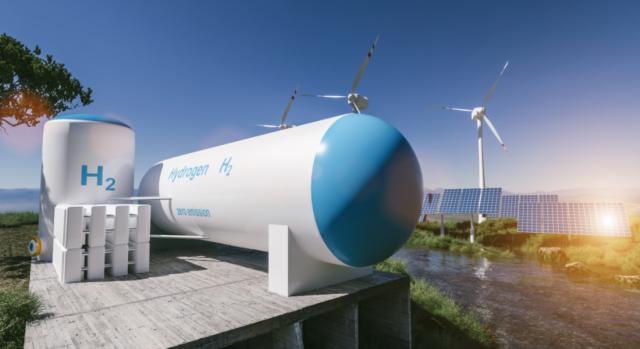
(Source: Alexander Kirch/Shutterstock.com)
The hydrogen pursuit is on for energy players in the U.S. looking to develop cleaner forms of energy as the world transitions away from fossil fuels and embraces the Paris Agreement.
Whether the push flourishes or fizzles remains to be seen, given high production costs associated with hydrogen.
Efforts are underway, however, to bring hydrogen energy—the most plentiful and lightest element on the periodic table—to the forefront as a low-carbon fuel source in Texas. As an energy carrier, hydrogen is capable of storing and delivering energy for use in fuel cells to generate power.
“Texas is actually the largest established hydrogen producer in the nation at the lowest cost already,” Nico Bouwkamp of Frontier Energy said during a January hydrogen-focused virtual hosted by The University of Texas at Austin (UT).
“Texas has excellent resources with regard to natural gas, renewable natural gas, although maybe not explored as much as it could be, but also solar and wind for the production of renewable hydrogen,” he added.
Bouwkamp is the technical program manager for Frontier’s Demonstration and Framework for H2@Scale project, a U.S. Department of Energy (DOE)-supported collaboration with the Gas Technology Institute (GTI) and UT among other partners. The project is part of a larger DOE-led hydrogen initiative.
The three-year project aims to increase knowledge of hydrogen’s integration potential, focusing on renewable hydrogen generation options in hopes of finding cost-effective hydrogen energy solutions. As part of the Texas project, partners will generate zero-carbon hydrogen on site to power a stationary fuel cell, providing power for UT’s Advanced Computing Center and fuel cell electric vehicles in Austin.
“What we’re doing is to demonstrate multiple renewable hydrogen generation options [such as] … hydrogen from electrolysis, from wind and solar as well as hydrogen from reformation of renewable natural gas and the different partners play a role in that,” Bouwkamp explained. “For example, Waste Management and pipeline operators are all part of our project to see how we can use this to come to a cost-effective hydrogen.”
Despite its environmental benefits and its ability to be produced using several resources such as natural gas, renewables and coal with carbon sequestration, costs associated with hydrogen production are considered its greatest challenge. It remains more expensive than fossil fuels.
“For cost-competitive transportation, a key driver for energy independence, hydrogen must be comparable to conventional fuels and technologies on a per-mile basis,” the Department of Energy’s Hydrogen and Fuel Cell Technologies Office said on its website. “In order for fuel cell electric vehicles to be competitive, the total untaxed, delivered and dispensed, cost of hydrogen needs to be less than $4/gge [gasoline gallon equivalent].”
The H2@Scale Texas project focuses on demonstrating multiple renewable generation options with storage, vehicle fueling and baseload use of hydrogen.
The initiative also involves developing an action plan for Texas, covering energy decarbonization, energy storage and fuel cell electric vehicle rollout. Efforts include identifying policy and regulatory barriers as well as potential hydrogen users, while also levering existing industry resources, Bouwkamp said, noting this centered on the Port of Houston.
Since the project was announced in September, progress has been made on pricing and selecting equipment, delivering some equipment to GTI for upgrades, initiating procurement of long-lead equipment (including a simple fuel unit with hydrogen generation and dispensing capacity), analyzing and compiling data and stakeholder engagement, according to Bouwkamp.
In Texas alone, expansion integration opportunities for hydrogen are abundant.
“Hydrogen is, as you know, a critical feedstock for many processes in chemical industries already underway,” he said. “If existing stranded renewables are obviously not used, they can be put to use and improve the return on investment for those operating renewable power farms.”
In addition to being used by multiple sectors or exported, domestically sourced decarbonized hydrogen can enable zero emissions for all modes of transportation and can be used for grid stability and energy storage, Bouwkamp explained, later adding expertise exists in Texas.
“All of that can lead to economic growth,” he said.
Currently, about 10 million metric tons of hydrogen are produced annually in the U.S., according to the DOE.
Recommended Reading
EOG Testing 700-ft Spacing in Ohio’s Utica Oil Window, Sees Success
2024-08-05 - EOG Resources’ test at the northern end of its 140-mile-long north-south leasehold produced IPs similar to those from a nearby pad.
EOG Resources Wildcatting Pearsall in Western Eagle Ford Stepout
2024-07-17 - EOG Resources spud the well June 25 in Burns Ranch with rights to the Pearsall well about 4,000 ft below the Eagle Ford, according to myriad sources.
Crackin’ It at Kraken: Inside the Bakken’s Ramped-up Private E&P
2024-07-24 - Kayne Anderson-backed Kraken Resources is producing more than 80,000 boe/d today and has a new Fitch Ratings credit score to take to the M&A bank.
E&P Highlights: July 22, 2024
2024-07-22 - Here's a roundup of the latest E&P headlines, with LLOG acquiring 41 blocks in the Gulf of Mexico and Saipem securing $500 million in contracts from Saudi Aramco.
In Ohio’s Utica Shale, Oil Wildcatters Are at Home
2024-08-23 - The state was a fast-follower in launching the U.S. and world oil industry, and millions of barrels of economic oil are still being found there today.
Comments
Add new comment
This conversation is moderated according to Hart Energy community rules. Please read the rules before joining the discussion. If you’re experiencing any technical problems, please contact our customer care team.






